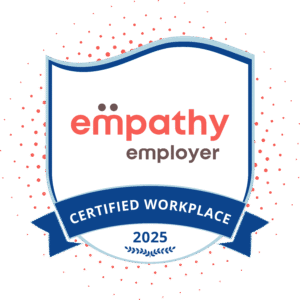At a time when some question whether empathy and high performance can coexist, the evidence tells a different story. The narrative that organizations must choose between empathetic cultures and exceptional results represents a fundamental misunderstanding of how modern high-performance organizations actually function. Far from being mutually exclusive, empathy and achievement are increasingly proving to be complementary forces that, when properly integrated, create sustainable competitive advantages that purely results-focused approaches cannot match.
High-Performing Organizations That Excel Through Empathy
Let us looks at some real-world examples of organizations, like Microsoft, Accenture, and Patagonia that are succeeding by incorporating empathetic approaches. By creating environments where understanding diverse perspectives becomes a strategic advantage rather than a distraction, they’ve developed more sustainable, adaptive performance capabilities than competitors focused solely on short-term metrics.
- Microsoft’s transformation under Satya Nadella provides perhaps the most compelling example of empathy’s performance impact at massive scale. When Nadella took over as CEO in 2014, Microsoft was struggling with internal competition, declining relevance, and a challenging company culture. Nadella explicitly centered his leadership approach on empathy, famously stating that “empathy makes you a better innovator” and embedding this principle into Microsoft’s operations. The results speak volumes: Microsoft’s market capitalization has increased more than fivefold, from approximately $300 billion to over $1.7 trillion. This growth wasn’t achieved by sacrificing performance expectations; rather, Nadella created an environment where understanding user needs and employee experiences became the foundation for demanding excellence with purpose.
- Similarly, Accenture has built its position as a global leader in professional services while maintaining consistent recognition as one of Fortune’s “100 Best Companies to Work For.” Under the leadership of Julie Sweet, Accenture has emphasized what they call “compassionate leadership” while simultaneously achieving record financial performance. Their approach integrates rigorous performance expectations with organizational practices that demonstrate deep understanding of employee needs – including substantial investments in mental health resources, personalized development paths, and flexible work arrangements designed through extensive employee input. These practices haven’t diluted performance standards; they’ve enhanced the company’s ability to meet them sustainably.
- Patagonia represents another instructive example of empathy-driven high performance. The outdoor clothing company’s commitment to understanding stakeholder needs – from employees to customers to the environment itself – has translated into remarkable business success. Despite (or perhaps because of) practices like encouraging employees to take time off for environmental activism, offering on-site childcare, and designing products with repair and longevity in mind, Patagonia has maintained profit margins that significantly outpace industry averages. Their approach demonstrates how organizational empathy creates alignment between purpose and performance rather than tension between them.
Research Connecting Empathy to Performance Outcomes
The connection between organizational empathy and business performance isn’t merely anecdotal – it’s increasingly supported by robust research across multiple performance dimensions. A comprehensive study published in the Harvard Business Review analyzed performance data from 170 companies across multiple industries and found that organizations scoring in the top quartile of their research data demonstrated 50% higher earnings (measured as EBITDA) compared to companies in the bottom quartile. This correlation between empathy and financial performance remained consistent across industry categories, company sizes, and geographic regions.
Research from Businessolver provides additional evidence of empathy’s impact on critical talent metrics. Their multi-year research shows over 90% of employees would be more likely to stay with an empathetic employer, while over 80% would consider leaving their current organization for a more empathetic one. Given that the cost of replacing an employee typically ranges from 50-200% of their annual salary (depending on seniority and specialization), this retention impact alone represents substantial financial value. The research further indicates that 77% of employees would work longer hours for an empathetic employer – suggesting that empathy drives not just retention but discretionary effort.
Innovation outcomes also show strong correlation with organizational empathy. A study published in the Journal of Product Innovation Management examined 150 product development teams and found that teams with higher empathy scores (measured through both self-assessment and observer ratings) produced innovations with 18% higher customer satisfaction ratings and 26% faster time to market. This research suggests that understanding user needs – a core application of empathy – directly translates to more successful innovation outcomes.
Perhaps most tellingly, longitudinal research from organizations like the Center for Creative Leadership shows that empathy isn’t just correlated with performance – it’s predictive of it. Their 10-year study tracking leadership effectiveness found that empathy scores were the strongest predictor of future leadership performance, outweighing factors including technical expertise, strategic thinking, and industry knowledge. Leaders with high empathy scores were consistently rated as more effective by both superiors and subordinates, and led teams that delivered superior financial results over time.
As research methodologies become more sophisticated in measuring both empathy and performance outcomes, the evidence increasingly suggests that understanding others’ perspectives and experiences isn’t merely compatible with high performance – it’s foundational to it.
Quantifying Organizational Empathy: The Empathy Employer Index (EEI)
While research clearly establishes the connection between empathy and performance, many organizations struggle to translate this insight into actionable strategies because empathy can seem subjective or difficult to measure. This is precisely the challenge that Empathy Employer Index℠ (EEI) methodology addresses – providing organizations with quantifiable insights into their empathy capabilities across multiple dimensions.
Unlike simplistic approaches that treat empathy as a single dimension, the Organizational Empathy Assessment Framework℠, consisting of nine key-pillars, uses research-backed Empathy Attributes Questionnaire℠ that evaluates empathy both from the employee’s perspective (how employees perceive their own empathetic behaviors) and as organizational practice (how employees experience the organization’s culture).
Crucially, the EEI doesn’t simply provide an overall score; it offers granular insights across nine specific dimensions influencing organizational culture, enabling precise identification of both strengths and development areas. This specificity allows organizations to target their improvement efforts on the particular aspects of empathy that will yield the greatest performance benefits in their context.
The quantification of organizational empathy provides several advantages for performance-focused leaders. First, it creates a baseline for measurement, allowing organizations to track progress over time rather than relying on anecdotal impressions. Second, it enables benchmarking against industry standards and high-performing organizations, creating context for understanding relative empathy capabilities. Third, it transforms empathy from a vague aspiration into a specific organizational capability that can be systematically developed like any other strategic competency.
Sustainable Performance: How Empathy Prevents Burnout and Attrition
While empathy’s impact on immediate performance metrics is compelling, its most significant contribution may be enabling sustainable performance over time by preventing the burnout and attrition that often undermine initially successful organizations. Research increasingly demonstrates that performance approaches lacking empathetic understanding create patterns that yield short-term results at the expense of long-term sustainability.
A five-year study conducted by the University of California found that organizations with low empathy scores but high short-term performance experienced what researchers called “success collapses” – periods where performance metrics suddenly declined after periods of apparent success. These collapses typically stemmed from accumulated workforce depletion, where high performers became exhausted and disengaged due to practices that demanded results without understanding human impacts. In contrast, organizations scoring high on empathy measures maintained more consistent performance trajectories with fewer dramatic fluctuations, even during challenging market conditions.
Research from the American Psychological Association quantifies this effect, finding that employees in low-empathy organizations are 2.6 times more likely to experience burnout symptoms and 3.2 times more likely to actively seek alternative employment. Given that burned-out employees show 63% higher absenteeism, 13% lower confidence in their performance, and 23% higher likelihood of emergency room visits, the performance impact of preventing burnout through empathetic practices becomes clear. Organizations that systematically develop empathy capabilities essentially create an “immune system” against the performance-depleting effects of burnout.
The mechanism connecting empathy to sustainable performance operates through several pathways. First, empathetic organizations identify early warning signs of depletion before they manifest as performance problems, enabling proactive intervention. Second, they develop more nuanced understanding of the specific factors creating strain for different employee groups, allowing for targeted rather than generic wellness approaches. Third, they create psychological safety that enables honest communication about capacity and constraints, preventing the silent accumulation of unsustainable demands.
The sustainability impact of organizational empathy extends beyond internal workforce considerations to market adaptability. Organizations with higher empathy capabilities consistently demonstrate greater agility during market shifts because they maintain closer connection to evolving stakeholder needs and detect weak signals of change earlier. A retail organization that systematically developed customer empathy capabilities identified changing shopping preferences 8-12 months before competitors, enabling more effective adaptation to market trends and maintaining performance during industry disruption.
These sustainability benefits don’t represent a trade-off with performance; rather, they enable more consistent performance over time. Organizations that integrate empathy into their operations escape the “performance cycles” that characterize many businesses, where periods of strong results are followed by recovery periods of suboptimal performance as organizations rebuild depleted capacity.
Key Takeaways - Empathy is a Performance Multiplier
The evidence is in front of us – organizational empathy and high performance are not competing priorities but complementary capabilities that reinforce each other when properly integrated. Organizations that develop sophisticated empathy capabilities consistently outperform competitors across multiple performance dimensions, including financial results, innovation outcomes, talent metrics, and market adaptability. This performance advantage stems not from relaxing standards or accepting mediocrity, but from developing deeper understanding that enables more effective execution.
The distinction between organizations that successfully leverage empathy for performance and those that don’t isn’t whether they value results – it’s how sophisticated their understanding is of what drives sustainable results. High-performing empathetic organizations recognize that performance doesn’t exist in opposition to human factors; it emerges from effectively working with human realities rather than against them. This recognition creates what might be called “empathetic ambition” – the pursuit of exceptional outcomes through approaches that understand and address the human dimensions of performance.
For leaders seeking to create high-performing organizations in increasingly complex environments, developing organizational empathy represents perhaps the most underutilized performance lever available. Unlike many performance initiatives that yield diminishing returns over time, empathy development creates compound benefits as improved understanding enables more effective approaches across multiple organizational dimensions. Rather than a performance trade-off, empathy functions as a performance multiplier that enhances the effectiveness of other initiatives while creating distinctive capabilities that competitors cannot easily replicate.
As business environments become more volatile, uncertain, and complex, this multiplication effect becomes increasingly valuable. Organizations that combine performance ambition with empathetic understanding create sustainable advantage not just because they execute current strategies more effectively, but because they detect emerging needs earlier, adapt to changing conditions more skillfully, and maintain the human capital required for continued innovation and execution. They recognize that in an age where technical capabilities increasingly converge, the ability to understand and respond to human needs – of employees, customers, and other stakeholders – represents the most defensible competitive advantage.
The question for performance-focused leaders is no longer whether empathy belongs in high-achievement organizations, but how systematically they will develop it as a core organizational capability. Those who continue to view empathy as optional or separate from performance will increasingly find themselves at a disadvantage compared to competitors who recognize and leverage the empathy advantage.
Research Sources:
- Harvard Business Review article: The Business Case for Empathy (2019)
- Satya Nadella’s book: Hit Refresh: The Quest to Rediscover Microsoft’s Soul and Imagine a Better Future for Everyone (2017)
- Harvard Business Review article: The Most (and Least) Empathetic Companies (most recent edition)
- Businessolver: State of Workplace Empathy Study
- Innovation and Empathy Connection Journal of Product Innovation Management: Empathy and New Product Development (Volume 36, Issue 1)
- Center for Creative Leadership: Empathy in the Workplace – longitudinal study
- University of California Berkeley: The Organizational Costs of Insufficient Empathy (2022)
- American Psychological Association: Work and Well-being Survey (2023)
- Gallup: State of the Global Workplace reports
- Salesforce Annual Impact Reports
- Cleveland Clinic: Empathy: The Human Connection to Patient Care
- Deloitte Human Capital Trends Report
- McKinsey & Company: The Business Value of Empathy






